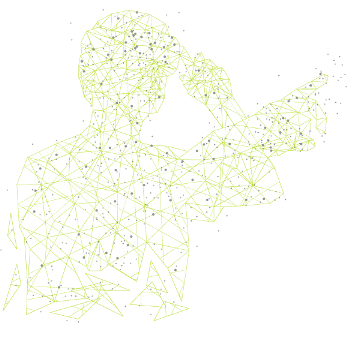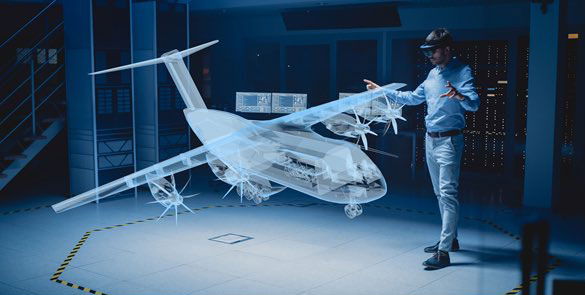Virtual Reality For Engineering Education & Research
Future forwarding learning and
research in your institution
In today’s fast-paced world, engineering and information technology is advancing at a breakneck speed. Technical education needs to be supplemented and in certain areas, driven by these technologies. The knowledge of a graduate engineer is now tagged with a half-life. With the rise in the pace of transition to obsolete knowledge, ‘obsoledge’ as Alvin Toffler puts it, technical education particularly faces the heat. Educators in this space, face the following challenges.
• Keeping pace with the technological advancements
• Effectively leveraging them by developing pedagogical strategies and instructional materials centered around them and
• Generating quality research. This creates the requirement for a high technology setup steeped right into the future, that doubles up as:
• A progressive learning center loaded with curriculum related content
• A high fidelity research cum collaboration center.

Recent Post
Solutions
Categories
Featured On

For educational purposes, Virtual Reality (VR) has been proposed as a technological breakthrough that holds the power to facilitate better learning. VR applications are based on the growing certainty that the next evolutionary stage is computers and telecommunications fusing into virtual environments. VR holds the promise of single handedly augmenting the existing curriculum and stimulating further research. While traditional notions of education, stimulating only one human sense, have been primarily intellectual, the unified hear-see-do experience facilitated by VR can be used to support complex understanding by stimulating and exploring all human senses. The versatility of a VR setup lies in the fact that it is truly multidisciplinary in nature and can be used across departments. With our proven expertise in setting up VR centers, prepare to get immersed in our VizCenter and rediscover education in your spheres of interest.

Learning by simultaneous hearing, seeing
and doing
Virtual Reality (VR) can be best defined as a form of visual human computer interface, characterized by an environmental simulation controlled by the user. Superior to text-based and desktop VR, immersive VR involves a combination of visual computing hardware and software along with data, that allows the user to interact with a three dimensional computer generated world using VR gadgets. VR goes beyond simulations, i.e., virtual worlds can embody arbitrary objects, abstract or concrete, and can be programmed to behave in ways that have no equivalence in the real world.
Recent Post
Solutions
Categories
Our Partners


VR is considered a great enabler in education. The constructivist theory of education proposes that the focus of education should be less on competition and more on collaboration. This is a matter of even greater significance now, as quality research, which has always been a collaborative effort, is the primary metric on which universities all over the world are being evaluated on. It is obligatory for universities of today and tomorrow to be focussed towards research than anything else. A VR environment that is setup to supplement the existing curriculum and simultaneously drive further research can essentially make this a reality. To allow educational tools to fall behind the pace of technological advancements would mean failing to tap the potential of a whole new generation of eager young minds.
The technological constructs that support this argument are:
• Gordon Moore’s eponymous law concerning the exponential rise in the computational power of the integrated chip and the decrease in size and cost of these devices simultaneously.
• The Pixels per dollar construct which has facilitated setting up highly sophisticated visual computing systems at a much lower cost. These two factors can be leveraged in a substantial manner in the field of education, by setting up immersive virtual reality centers that would be multidisciplinary in usage. VR has immense potential as a medium of education, specifically in the visualization of abstract concepts, in a much larger than life scale with options that allow better mastering and retaining of that
knowledge. Further virtual labs that can be setup using VR can facilitate research at a fraction of the cost involved in setting up physical labs while enabling greater experimentation. Research has shown that various aspects of a virtual reality environment, affect education on three metrics.
• Immersion
• Interaction
• Engagement
These three factors need to be seriously considered while setting up a VR center in universities to ensure maximum effectiveness on learning.
MECHANICAL ENGINEERING
Unleash the Mechanical Engineer in you
through Virtual Reality
An approach based on 3D visualization can cement the foundation of engineering graphics and engineering mechanics which are imperative for a better understanding of everything else in the domain. A strong foundation in CAD, one of the prerequisites these days for any successful mechanical engineer, is no longer just about being able to model in 3D. It is about animating the models and simulating them in virtually created real life conditions.

Design engineers can be immersed in an audio-visually coupled virtual environment in order to enable direct interaction with the design process in real time Internal Combustion engines learnt using a VR environment can ignite the passions of many an automobile engineer. Simulation of the various components in a virtual environment would be more effective than a live lab experiment as there would be no constraints with respect to visibility of internal combustion reactions. With Computer Aided Engineering being the industry norm OEMs throughout the world have acknowledged that virtual prototyping is the way of the future. A lot of potential research centered around Model Based Design of various components followed by testing in a virtual environment is being done. The validity of these models have also been found to be high. The resulting cost savings by such simulation and testing in virtual environments has created an urgency amongst manufacturers to adopt such methods. Pre preparedness in such technologies will help engineers expedite the development cycle of products.
-
Dynamic simulation aids for effective teaching
-
Virtual workshops
-
A presentation environment that supports dynamic content
CIVIL ENGINEERING
Lay down rock solid foundations and even
complete structures using Virtual Reality
Conventional teaching of civil engineering directly show the final form of architectural elements depriving the learners to observe the physical evolution. Using VR, it is possible to bring better perspectives using didactic models through visual simulation of the construction process which would dynamically produce changes to the geometry. When the construction planning timeline in phases is integrated with the design information, 4D (3D + time) models are created.

The entire construction process can be virtually simulated using Virtual Reality which would facilitate much better understanding of the process and the virtual model can be interactively manipulated with. Elements of structural analysis such as bending moment, shear stress, creep can also be better visualized and understood. VR allows Geo Informatics to be viewed the way it is supposed to be- in 3D. Real life projects such as rehabilitation of a dilapidated building, require constant evaluation at a very early stage and constant monitoring before any decision becomes definitive. Using VR, detection of structural anomalies, replacement of damaged resistant elements and the adaptation of the building to new uses can be done very effectively by rapid surveying and mapping of damages. There is a huge scope for application development, that leverage geospatial virtual environments, for users with no prior GIS experience. Further simulating presence in situations where a physical presence is not possible in areas like mining can be studied in a VR environment.
-
A 4D teaching environment
-
Huge potential for all the sub disciplines in Civil engineering
-
Simulating real life industry problems and delivering solutions
COMPUTER SCIENCE
Start developing the virtual and the
real of Virtual Reality
Virtual Reality studies are now an integral part of any computer science curriculum. An existing VR setup will facilitate better exploration of core technical information and background theory amongst students. Learning new and emerging trends like General Purpose GPU computing and the likes can be done effectively in the VR center. Further through active involvement with the VR center, the computer science department can drive the content creation and development of applications centered around them for usage in the VR center.

In a country like ours where IT is a major driver of growth, a superior foundation in these technologies amongst graduates will go a long way in sustaining the growth. The VR center can drive the development of programs around practical applications of computer science and software engineering. Information technology is not any longer just about writing code or building personal computers. It is about creating solutions and solving real problems faced by industry, business, medicine, entertainment, and every sector of our society. Working on such applications in a VR environment early on will ensure much greater productivity amongst engineers at the work place. The scope of VR related research in computer is particularly immense. There is a lot of interest surrounding the development of applications that leverage and extend the capabilities of existing gadgets and further result in the development of newer gadgets. Development techniques are cross referenced between different application areas providing fundamental best practices.
-
A test center for simulations and programs
-
Learning center for the latest technologies
-
Application development center for a variety of uses
CHEMICAL ENGINEERING
View Chemistry in its element, larger
than life using Virtual Reality
The constraints of a microscopic study of chemistry can all be overcome in a virtual reality environment. Navigation at the sub atomic level through VR gadgets makes Chemistry larger than life. The foundations of many industrial processes also lie in the understanding of chemical elements and their properties. Simulation of industrial processes such as polymerization and petrochemical plants in a reactor room can take understanding to a whole new level. Every stage can be detailed and interactions of elements with catalysts can be simulated with real time accuracy.

Experiments, even those that can not be normally done in real operating conditions with the best of equipments, can now be done in these virtual laboratories. As a special outreach program involving real life problems virtual reality can be successfully applied to existing chemical plants for exploring simulated hazards. Virtual reality has the potential to immerse personnel into an interactive and controlled virtual world containing simulated hazards. This may operate as an enhancement to existing training methods thus facilitating improved training and safety awareness. Related streams that also include biological elements such as Biochemisty, Biotechnology, Bioinformatics involve intensive and expensive training in laboratory procedures in terms of equipment and experienced guidance. VR simulation offers a very cost effective alternative to training students in the use of sophisticated instruments that are employed in modern labs.
-
Highly sophisticated and economical virtual alternative to physical labs
-
An invaluable teaching aid with larger than life visualization at the sub atomic level
ELECTRICAL ENGINEERING
Electrify Electrical Engineering related
programs using Virtual Reality
Interaction with a virtual reality environment through the VR gadgets is mainly driven by electrical engineering elements. Certain aspects of control systems such as haptic feedback using servo motion control, speech recognition which are an integral part of VR setups can be shown in real time for better understanding. Mechatronics is another area which is seen as a driving force in various industries by providing transducers for sensor technologies. Better appreciation of mechatronics through VR simulations can generate greater interest. Robotics, one of the mainstays in many institutes of higher education and certainly one of the students’ favorites, at least when it comes to its practical applications, can be made equally interesting in theory through a VR based approach.

There is immense scope for research on advancements in virtual reality through developments in electrical engineering. Research on the development of gadgetry to perform surgical procedures on virtual tissues such that the surgeon feels different degrees of resistance to the motion of a scalpel at different places along the tissue and related applications where there is an interaction with a virtual object through a gadget are dependent on new electrical and electronics technologies. A specific research focus area is in the field of BioMedical engineering where engineering principles are applied to solve problems in medicine and biology.
-
Engaging environment to make theoretical aspects more interesting
-
Research space for a multitude of applications
-
Wide range of application simulation
AEROSPACE ENGINEERING
Experience Aerospace Engineering
from a higher plane of thought
Fully immersive visualization of complex concepts in structural and dynamic design such as flows in jet engine combustors and inlets using VR simulations facilitate greater understanding. Parts familiarization, theories of operation of various components in an aircraft in a highly interactive and rich media environment, in acquiring knowledge in less time and with increased skill. With parts getting increasingly complex, understanding potential maintenance and repair tasks can be facilitated in a virtual environment. Simulation of the appearance and behavior of smoke in a microgravity habitat can be used for fire detection and visibility studies. Contrasting with highly expensive high fidelity pilot training simulators for a specific aircraft type, a Virtual Cockpit (VC) with pilots immersed in a stereoscopic virtual environment, wearing a HMD and a pointing device to interact with the virtual cockpit devices can prove to be more useful. A VC can be easily reconfigured by simply switching the cockpit model database and the attached flight mechanics.

Aircraft component design and manufacture use VR in what is referred to as touch labour manufacturing. This entails the use of a head mounted display with motion tracking and superimposes diagrams or text onto the surface of a workpiece and stabilizing it there on specific coordinates, so that the appropriate information needed by a factory worker for each step of a manufacturing or assembly operation appears on the surface of the workpiece as if it were painted there.
-
Virtual cockpits
-
Immersive visualization environment for structural and fluid dynamics
-
Design environment for aerodynamic simulations
The Digital revolution has brought with it a
strong need for tools to make sense of this
multitude of data.
Visual computing leveraging human cognition, proves to be an invaluable tool, to mine, analyze and present insights from such voluminous data. As a facilitator to achieve a bigger goal, the growth and development of visual computing technologies has corresponded with the growth in the amount of digital data created and can be rightly termed a ‘Vis Major’.

We at VIZEXPERTS, have the vision to be in the vanguard of facilitating the data to decisions transformation through superior visual computing.
We pride ourselves in our rich human capital that includes a formidable in-house R&D team and a zealous field sales team led by a prudent management team. With an extensive clientele representing the most prominent names in defense, technology and the government we enjoy a reputation that is nonpareil in the industry.
Virtual Reality centers to facilitate superior collaboration and drive greater research have been successfully deployed by us at DRDO, ISRO.
VIZCENTER®
VizCenter is our flagship audio visual environment that uses the best of visual computing technologies in a highly configurable fashion to setup the whole gamut of collaboration centers, from corporate board rooms to virtual reality centers. As an integrated solution, VizCenter includes high-fidelity projection based immersive displays, modern graphics hardware, software tools, user interface devices and audio-visual integration from the world’s leading technology majors and system integrators. With our core competence in 3D visualization technologies we invariably deliver on
our promise of the best possible solution for any given requirement.
To create an advanced learning environment and facilitate better research at universities, VizCenter can be configured to setup a versatile Virtual Reality environment that can allow applications for multiple disciplines. Some of the differentiating elements of a VizCenter configured for a Virtual Reality environment are:
-
Highly scalable
-
Highly configurable
-
High operational life
-
Low cost of ownership
-
VR softwares
-
Interaction devices
-
Simple audio video management
Screen configurations

Multichannel 3D Projection system

VR gadgets

Recent Post
Solutions
Categories
Our Partners

Featured On





